2015-05-28 By Robbin Laird
In late March 2015, I had a chance to visit the new generation British carrier, the HMS Queen Elizabeth and passed by the rapidly emerging Prince of Wales as well.
Then the next day after the visit, I sat down with Royal Navy and Royal Air Force senior personnel to discuss the way ahead from an operational point of view.
Earlier, I have visited the USS America and CVN-78 or the USS Gerald Ford, so that I have had a chance to look at the new generation large deck strike and assault ships.
In a separate piece, I looked at the different approaches of each ship in some detail, and focus on a future dynamic in which all three might work together to discuss the effects which could be delivered among the three ships as a synergistic force.
The British invented carrier warfare.
“HMS Ark Royal was arguably the first modern aircraft carrier. She was originally laid down as a merchant ship, but was converted on the building stocks to be a hybrid airplane/seaplane carrier with a launch platform.
Launched on 5 September 1914, she served in the Dardanelles campaign and throughout World War I.”
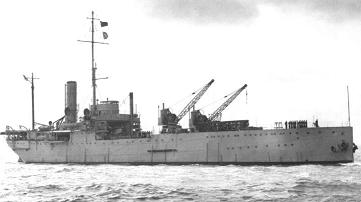
(See the comprehensive history of British aircraft carriers by David Hobbs, British Aircraft Carriers: Design, Development and Service Histories: Naval Institute Press, 2014).
Arguably, the British are reinventing the large deck carrier under the influence of a confluence of a number of technologies (some similar to the USS Gerald Ford) and the impact of the F-35B (similar in some ways to the USS America).
But assuredly, the carrier is a key part of the transformation of British joint forces, and their ability to operate forward.
And given the general impact of the F-35 on warfare, the cross cutting transformation driven by the British carriers and the British integration into the global fleet of F-35s will drive significant change in combat approaches as well as generating innovative ways to deliver combat effects.
In 2007, I was aboard HMS Illustrious and was aboard one of the first Ospreys to land on that ship, and the ship was indeed the first foreign warship to land the Osprey.
The most recent is a South Korean large deck amphibious ship, so that shows what eight years of evolution of aviation can do.
Marines were flying their Harriers during my visit doing the certification so necessary to fly this complex aircraft.
The British Harriers were in Iraq or Afghanistan, and the deck was empty of British Harriers, which provided a very good opportunity for the Marines to do their flight certifications.
Also, the ship has a wonderful ski jump for the aircraft to use, which is also present on the HMS Queen Elizabeth.
The HMS Illustrious is a 22,000 ton ship; the HMS Queen Elizabeth is a 65,000 ton ship.
The relationship seen that day aboard the HMS Illustrious between the USMC and the Royal Navy carries over in a major way into the operational future of the HMS Queen Elizabeth.
Both the Marines and the RAF will fly F-35Bs and will train together at Beaufort Marine Corps Air Station and will forge a broader community of growing F-35B users world wide.
And given the integration of the Marines into the USN assault and strike force and the RAF’s integration in the Royal Navy’s operations of the carrier and the task force, their cross innovations will influence the future of naval warfare, and the projection of power from the sea.
The first thing you notice as you approach the ship is how large the ship really is.
And when you get onboard, the first thing you notice is how large the flight deck is.
I was told it was approximately 90% of the flight deck of a Nimitz class carrier; and the deck is very wide indeed.
The second thing you notice are the two islands aboard the ship.
This is due to the fact that it is not a nuclear carrier and the exhausts for the engines exit on two parts of the flight deck; and there is an island incorporating those exit points. The forward island is used to operate the ship; and the aft island runs flight deck operations.
And in a crisis, either island can perform both tasks, but visiting the two islands it is clear that the designers have focused on ways to enhance the workflow for the two different tasks, namely running the ship and operating the aircraft aboard the flight deck.
During the visit, I walked the flight deck with Royal Navy and Royal Air Force personnel and stood at the end of the ski jump.
It was a rainy and windy day, and the width of the deck before you, coupled with the projected operational footprint of the F-35B clearly brings up a vision of the commanders organizing task forces for force insertion from this deck.
It is a cross between the notion of a large deck amphibious assault ship, like the USS America, and a strike carrier, like CVN-78.
As David Hobbs put it:
Ships such as the USS America (are) able to provide both an amphibious force and air power from the sea in measures that are flexible and adjustable, a capability that analysts are referring to as “triphibious operations”, combing land, sea and air operations in a single ship that operates as an operational hub.
Queen Elizabeth will but just such a ship, but will approach ‘triphibious crossover’ from an original design as a strike carrier, whereas America began as an amphibious assault ship with an enhanced air capability.
The two may well operate in a similar fashion and from the basis of a new approach to naval aviation in the twenty-first century, the big-deck air-capable ship with a number of roles, many of which can be carried out concurrently.[ref]David Hobbs, British Aircraft Carriers: Design, Development and Service Histories (Annapolis, Maryland: Naval Institute Press, 371.[/ref]
The flight deck is built by Laird Shipbuilding (one of the members of the Carrier Alliance of yards building modules for the ship), so I felt at home aboard this flight deck.
And to the right of the ski jump, in the water, were 4 Polaris submarines. And the dock next to the ship is called the Hood dock, where HMS Hood left to pursue Bismarck and to where Prince of Wales returned after successfully completing the mission.
And also looking to the right from the top of the ski jump one sees the bridges under which this large ship has to sail to get to her homeport of Portsmouth.
The ship has a mast which collapses to allow it do so under the current bridge, but, interestingly, a new bridge is under construction, which hopefully will not get in the way!
The ship is designed to operate around 40 aircraft, F-35Bs and helicopters, and possibly Ospreys in the future.
The plan is to operate 24 F-35Bs, 8 ASW helicopters and 5 crows’ nests, probably off of Merlin helicopters.
The design emphasizes flexibility, with accommodation for 250 Royal Marines and the ability to support them with attack helicopters and troop transports up to Chinook size and larger.
In addition, to the innovative F-35B, the Royal Navy will add a new airborne command post to the deck, which will be available for a multiplicity of tasks in ship defense.
With the F-35B, the strike concept will be different from that of the USN and its large deck carriers. As an RAF officer put it: “The plane is so easy to fly, we will focus on getting the maximum effects from the strike force, and not have to focus as much attention to flight choreography as one has to do with legacy aircraft.”
The focus is clearly on effects generated from an aircraft carried designed for 24/7 operation.
The F-35B launched from the carriers are part of the picture; the very significant C2 capabilities aboard the ship are another. With the carrier afloat, the RAF is looking to build synergy among the various land based and carrier based aircraft to generate combat effects.
As an RN officer put it: “The strike force could be commanded from the ship, from the ground or from the air. We are building flexible C2 in order to get maximum combat value from aircraft launched from the carrier.”
The F-35B as a flying combat system, capable of integrated air operations with every other F-35 flying in the combat area is a significant foundation for shaping what the Queen Elizabeth will do in combat.
The reach of the F-35Bs coming off of the Queen Elizabeth will be expanded by the range of the operational fleet of other F-35s and the data grid generated over the expanded battle space.
And leveraging what Typhoons will be able to do as they undergo their current weapons modernization program will only enhance the strike effects of an integrated air-sea combat air force.
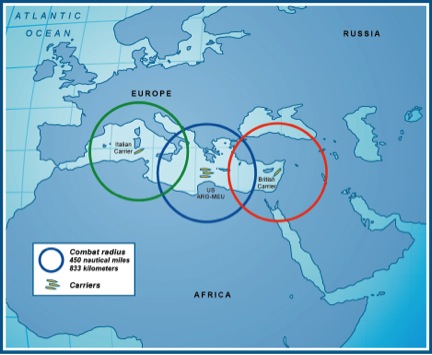
Projected forward in time, one can envisage how this might operate.
The Queen Elizabeth is in the Eastern Mediterranean and with its integration with the other F-35Bs aboard USN-USM or Italian ships, the data coverage would be significant.
The Typhoons operating in Cyprus would have a forward controller and defense shield as well as with the F-35Bs target acquisition elements. The Typhoons could operate with “greater survivability and lethality,” as one RAF officer put it.
Another scenario one could imagine is with regard to Baltic defense.
Rather than the current approach which requires sequential and segmented defense buildups to deal with the threat or reality of a Russian invasion of the Baltics, with the coming of the F-35 and the Queen Elizabeth one can envisaged a just time strike and deterrent capability.
If the Finns buy F-35s, they could deploy their aircraft in national defense and at the same time be part of a Baltic defense; Norwegian and Danish F-35s could operate over the Baltics as well.
Now a strike and ISR grid has been laid over the Baltics which can both detect and strike any advancing Russian forces and reassure the Baltic republics that there is not simply a demonstration deterrent force of a handful of aircraft, but a force which could interdict and defeat any Russian invading force.
Enter the Queen Elizabeth or a Marine Corps MAGTF aboard a large deck amphibious ship.
These forces can now be inserted directly into the deterrent or battlespace.
The F-35Bs being the edge of the insertion and integrate with an allied deterrent and strike force.
The HMS Queen Elizabeth is being built for 21st century operations, and is not simply repeating the approach of the past three decades.
And a number of innovations built into the ship are designed to enhance the capability of the Royal Navy and Royal Air Force to shape a new approach.
Several innovations one sees aboard the Ford can be found aboard the HMS Queen Elizabeth: significant power generation, significant C2 capabilities, very large rooms for reconfigurable C2 suites for operations across the Range of Military Operations (ROMO), as well as well designed work areas for the F-35B crews which will handle the operations and data generated by the F-35 to the fleet.
Significant power generation means that future developments can be accommodated, including the probability of the coming of directed energy weapons. The ability to drive the computer power necessary for evolving C2 is significant as well.
Walking through the ship, one sees miles of cable run to support operations, and notably to provide for robust and redundant C2. In fact both the Ford and the QE really have prioritized C2 in way that will allow these ships to play key roles in supporting not only a task force at sea but an overall joint or coalition insertion force.
The ship infrastructure is supported by an integrated management control system. IPMS or the integrated platform management system which provides integrated management to support operations and combat management.
This “brain” of the ship is designed to manage the workflow of the ship and to provide dynamic information to enable the infrastructure aboard the ship to support sortie generation rates for the mix and match strike force.
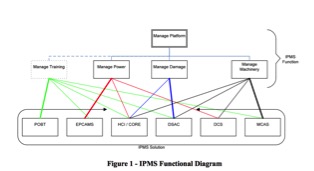
According to an L-3 (the designer and builder of the system) white paper on IPMS:
The QE Class are completely networked ships and IPMS is one of many electronic systems that will be provided.
To support the ships operational mission, and to ensure the platform systems are configured correctly at all times to support air operations, the IPMS has interfaces with the Combat Management System (CMS), the Air Group Management Application (AGMA) and a significant number of cameras provided by Visual Surveillance System (VSS).
This, along with the many platform, power and propulsion system interfaces, enables real time information relating to the status of systems to be displayed to decision makers throughout the vessel.
This interaction with the Mission Systems does, however, require that IPMS be designed, configured and authorized for operating in the UK Secret domain.
Information Management and HMS Queen Elizabeth
And the builders of the ship highlighted the integrated information aspects of the ship in the following manner:
The ships will each have a fully integrated command system, which has three functional areas:
Information System :The computing hardware, internal Networks and C4I software applications to support effective command and control on the carrier. E.g. – Considerable work has been done with Royal Navy and Royal Air Force
Information Defence Lines of Development to understand how the data repository on board will be accessed by new and legacy systems and how that repository will be configured in the future.
Communications: The communications equipment to support the required voice and data services. E.g. – an emulation of the Communication Control Management System and the Tactical C2 Voice system have been procured to exercise the business process of configuring the carrier for internal and external communications.
Air Management and Protection System: The on-board sensor and weapon systems for the management of aircraft in the air and on deck and the defense of the ship.
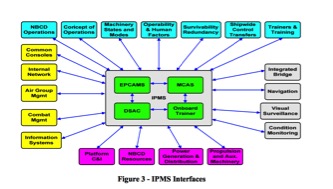
Walking below deck, the reconfigurable C2 suites are very impressive.
Of course, there are the suites for the most sensitive information, but a large area can be configured to support various types of C2 arrangements dependent upon the crisis, whether humanitarian or combat.
The F-35 requires its own workspaces to accommodate its security requirements and data management.
The ship is built with clearly configured areas to optimize the ability of the F-35Bs to operate aboard the ship and to support the flight and operations crews to optimize sortie generation aboard the ship.
The ship is designed to leverage the advantage of the F-35B and the space and energy savings of NOT operating catapults aboard the ship.
This also effects RN thinking about that core reality of operations, namely deck spotting and ways to most effectively use the deck in combat.
And there will be a landing system aboard the HMS Queen Elizabeth which is designed to facilitate F-35B landings as well.
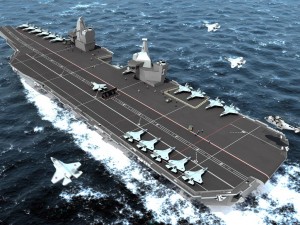
The landing system will allow a more automatrf process, enhancing both safety and sortie generation.
The mix and match skill set to operate rotorcraft, strike aircraft, and possibly tilt-rotor will be an important core competence learned in the past and applied to this ship going forward. It is about deck spotting, workflow from the hangar space to the flight deck and weapons loading. The ability to launch a mix and matched force – in terms of aircraft as well as weapons – will be a core competence of the combat team aboard the ship.
The HMS Queen Elizabeth in common with CVN-78 has a new way to load weapons and to configure the weapons loads to enhance the safety and speed of the weaponization process.
There is a highly mechanized weapons handling system and advanced machinery automation. The weapons are brought to either end of the deck to be loaded onto the combat aircraft; and the mechanism for loading and moving the weapons can provide for a mix and match capacity to push the proper loads to the particular aircraft for the missions of the day. In fact, the system aboard the HMS Queen Elizabeth can prepare those loads the night before the early morning missions.
The UK approach to building a complex weapons enterprise means that there is a common stockpile supporting the strike force. This means that the numbers and types of weapons have been necked down and the introduction of new weapons will again be built around commonality which will allow the carrier to optimize its ability to arm the strike force as well.
With the common training and software between the RAF and USMC F-35Bs, certification for cross weaponization is certainly a clear possibility moving forward as well. The common pool of weapons in support of the F-35 is an important enabler for a resupply effort as well, whereby as the UK operates its carrier forward it could receive weapons from foreign stockpiles of common weapons as well.
The ship is clearly designed with maintainability in mind. One example is that the engine shafts can be taken out while the ship is in the water and be repaired, not necessitating a dry dock to do those repairs.
As the builders of the ship put it:
Affordability of through life support has also been a key driver in adopting a commercial design.
Key operational spaces can be readily reconfigured and additional equipment inserted in a cost effective and timely manner to suit the future requirements of the Armed Forces and the nation.
Ship manning is significantly reduced aboard the HMS Queen Elizabeth. High levels of built-in automation have been introduced to minimize manning requirements and the qualifications of aboard personnel would be adjusted as well to operate a highly automated ship.
Again, as the builders of the ship put it:
The Highly Mechanized Weapon Handling System enables a streamlined crew to operate a vessel much larger than the carrier which it replaces, meaning that each ship will have a total crew of 679, only increasing to the full complement of 1,600 when the air elements are embarked.
In other words, current crew complement for the vessel is 679 sailors, compared to 3,200 for a Nimitz-class carrier of the U.S. Navy.
Given a tons per person operating measure, the UK will be shaping an innovative way forward.
In short, this is not your grandfather’s aircraft carrier.
Neither in terms of what will fly off the deck nor how it will operate nor how it will generate combat effects.
Not only is the F-35 a break through capability so is the design of in many ways a radically new large deck carrier.
The RN is looking with the RAF to reduce significantly personnel necessary to launch its air compliment, than does the USN with regard to its large deck carriers, which operates many aircraft, which the F-35B will operate to replace.
This is a clear area where the plane and the ship merge into a very different approach.
It will require nothing less than a transformation of the RAF and the RN in operating the ship and generating the kind of combat effects crucial to 21st century operations.
And Hobbs projected an interesting future for ships like the HMS Queen Elizabeth and the USS America:
Adaptable carrier designs represent a modular approach, with embarked aircraft or marine forces offering capabilities across the spectrum of warfare and humanitarian relief from a common hull with its small ship’s company, automated storage facilities and medical facilities.
They must represent the long-germ future for every navy that aspires to be more than a coastal patrol force.[ref]David Hobbs, British Aircraft Carriers: Design, Development and Service Histories (Annapolis, Maryland: Naval Institute Press, 357.[/ref]
Editor’s Note: With regard to the original HMS Ark Royal (and the credit for the photo):
http://www.naval-history.net/OWShips-WW1-04-HMS_Ark_Royal.htm
Commissioned early in December 1914 and sailed for Dardanelles on 1 February 1915, arriving at Tenedos on the 17th. Although hampered by the poor performance of her sea planes she provided much-needed reconnaissance for the bombardment of the Turkish forts.
Involved in many operations March-April 1915 and covered the landings from 25 April onwards, but at the end of May was withdrawn to Imbros where she became in effect a depot ship for all aircraft based there (she was too vulnerable to U-boat attack to be risked at sea).
To Mytilene and Salonika from November 1915 to March 1916, then back to Mudros as parent ship to No 2 Wing, RNAS. Two of her Sopwith Baby Seaplanes attempted to bomb Goeben in January 1918. To Syra as parent ship through Dardanelles after the Armistice and operated in the Black Sea, transporting aircraft to Batum. Withdrawn at the end of 1919 to support Somaliland campaign against the ‘Mad Mullah’. Sea of Marmora and Black Sea 1920, covering withdrawal of White Russian forces from Crimea, and carried aircraft to Basra, in the Persian Gulf.
In reserve at Rosyth after refit November 1920~April 1921. Recommissioned September 1922 to take aircraft out to Mediterranean during the Chanak Crisis, refitting at Malta in April 1923 before returning to Dardanelles.
Renamed Pegasus in December 1934 to release name for new carrier. Survived to fight in Second World in various capacities, and sold in December 1946 for conversion to Panamanian merchant ship. As Anita I, started conversion at Antwerp but the ship was sold for BU in June 1949. (Conway’s All the World’s Fighting Ships 1906-21)
The first slideshow shows the Osprey and USMC Harriers operating aboard HMS Illustrious in the 2007 training exercise and are credited to Second Line of Defense.
The final photo is credited to the Royal Navy and was shot when in September 2013, the Osprey landed again on the ship.
The second slideshow photos were shot during the visit to HMS Queen Elizabeth and were shot by the RN/RAF team and are credited to them.
- The first photo shows the ski jump on the flight deck for the F-35B. The second photo is of the ski jump and a shot of the Hood Dock from which HMS Hood left to go after Bismarck and to which HMS Prince of Wales returned after the Bismarck was sunk.
- The third photo is shot from the ski jump and looks down at the entire flight deck.
- The fourth photo shows Robbin Laird with one of the HMS Queen Elizabeth team at the end of the flight deck.
- The fifth photo shows several members of the team who provided the tour of the ship.
- The sixth, seventh and eighth photos show the islands aboard the flight deck.
- The ninth photo provides another shot of the flight deck; the tenth photo is a shot of the reconfigurable C2 spaces aboard the ship;; the eleventh photo shows the massive crane used in the course of construction.
- And the final photo shows those who provided the tour for whom more than thanks are due for providing insights into a key element of evolving air and sea power.
Special thanks goes to my hosts aboard the HMS Queen Elisabeth who included Group Captain Paul Godders, Cdr Uves Wood, Royal Navy, Lt Sarah Simmons RN – QNLZ Senior Air Engineer and WO Mick Davidson – ex QNLZ Air Engineering Department Coordinator now Fleet Air Arm Command Warrant Officer.

